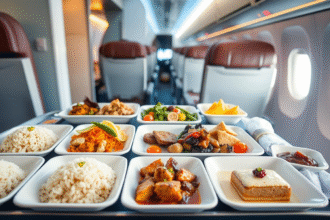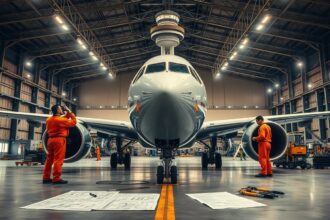Ever wondered how many people can fit on your next flight? Airplane passenger capacity changes a lot depending on the plane and how it’s set up.
passenger capacity
How many seats an airplane has depends on the airline. They think about comfort, how much fuel it uses, and how busy the route is. Each plane type has its own way of arranging seats, from basic to fancy.
Knowing about aircraft seating capacity helps you choose better when you book a flight. It’s good to know if you want more room or prefer flying when it’s less busy.
Key Takeaways
- The seating capacity of an airplane is influenced by its model and the airline’s configuration choices.
- Different classes of service offer varying levels of comfort and amenities.
- Airlines adjust their seating configurations based on route demand and passenger preferences.
- Understanding airplane seating capacity can enhance your flying experience.
- Factors such as comfort and fuel efficiency play a role in determining an aircraft’s seating arrangement.
Understanding Aircraft Seating Fundamentals
When you step onto a plane, knowing about aircraft seating can make your trip better. It’s not just about the number of seats. It’s about how they’re set up, how comfy they are, and how they affect the plane’s capacity.
aircraft seating fundamentals
How Aircraft Capacity is Measured
Aircraft capacity is based on how many seats fit safely in the cabin. Several things affect this, like safety rules, the cabin layout, and the seat type. The Federal Aviation Administration (FAA) sets rules for airlines to follow.
To figure out capacity, they count the space for passengers. They consider the space for seats, aisles, and emergency exits. Airlines and plane makers work together to fit as many seats as possible safely.
Certified Maximum vs. Typical Passenger Loads
There’s a big difference between an aircraft’s certified maximum capacity and its typical passenger load. The certified maximum is the highest number of passengers allowed, by law. The typical load is how many passengers actually fly, which can be less.
- The certified maximum is set by safety rules and plane design.
- The typical load depends on demand, airline plans, and market competition.
Knowing this helps us see how airlines balance making money with keeping passengers safe and comfortable.
Commercial Narrow-Body Aircraft and Their Passenger Capacity
Knowing how many passengers narrow-body aircraft can carry is key for airlines and travelers. These planes, with a single aisle, are perfect for short to medium flights. The number of seats varies by the plane’s make, model, and how airlines set them up.
Boeing 737 Family Capacity
The Boeing 737 family is a top choice for narrow-body aircraft. It comes in different models, each with its own seating capacity.
737-700, 737-800, and 737 MAX Variations
The 737-700 can hold about 140 passengers. The 737-800 seats up to 180, depending on the setup. The 737 MAX series has similar or slightly higher capacities than the older models.
Single-Aisle Configuration Efficiency
The Boeing 737’s single aisle makes boarding and leaving the plane quick. This is why airlines love it for busy routes.
Airbus A320 Family Capacity
The Airbus A320 family is also a big player in the narrow-body market. It competes closely with the Boeing 737.
A319, A320, and A321 Seating Differences
The A319 is the smallest, with 120-150 seats. The A320 seats 150-180 passengers. The A321 can hold up to 230 passengers, depending on the setup.
Neo Variants and Capacity Changes
The Neo (New Engine Option) versions of the A320 family are more efficient. They have slightly different capacities due to new options and better fuel use.
Regional Jets and Their Seating Configurations
Regional jets are for shorter trips and have smaller capacities, from 50 to 100 passengers. Examples include the Bombardier CRJ and Embraer ERJ families.
| Aircraft Model | Typical Passenger Capacity | Maximum Passenger Capacity |
| Boeing 737-700 | 140 | 149 |
| Boeing 737-800 | 160-180 | 189 |
| Airbus A319 | 120-150 | 156 |
| Airbus A320 | 150-180 | 195 |
| Airbus A321 | 180-230 | 236 |
Wide-Body Aircraft Passenger Capacity
Wide-body aircraft are the giants of commercial aviation. They offer a lot of room for passengers on long flights. These aircraft come in different sizes, allowing airlines to choose the right one for their routes and passengers.
Boeing 777 and 787 Dreamliner Capacity
The Boeing 777 and 787 Dreamliner are top choices for airlines. The Boeing 777 has models like the 777-200, 777-300ER, and the new 777X. Each model can carry different numbers of passengers. The 787 Dreamliner also has various versions, giving airlines more options.
777-200, 777-300ER, and 777X Capacities
The 777-200 can hold between 312 and 388 passengers. The 777-300ER seats 368 to 451 passengers. The 777X is expected to carry even more, making it great for busy routes.
787-8, 787-9, and 787-10 Seating Arrangements
The 787-8 Dreamliner seats 242 to 330 passengers. The 787-9 can hold 290 to 420 passengers. The 787-10 seats 330 to 440 passengers. These options let airlines pick the best fit for their needs.
Airbus A330, A350, and A380 Capacity
Airbus also has a range of wide-body aircraft, like the A330, A350, and A380. The A330 seats 300 to 440 passengers, depending on the setup. The A350 is known for its efficiency and flexibility. The A380 is the largest commercial plane, able to carry over 500 passengers in some setups.
| Aircraft Model | Typical Seating Capacity | Maximum Seating Capacity |
| Boeing 777-200 | 312-388 | 440 |
| Boeing 787-9 | 290-420 | 430 |
| Airbus A330 | 300-440 | 460 |
Comparing Long-Haul Aircraft Capacities
Looking at the capacities of these wide-body aircraft, we see a wide range of options. This flexibility is key for airlines to meet the needs of different routes and passengers.
Factors Affecting Airplane Passenger Capacity
Knowing what affects airplane passenger capacity is key for airlines and travelers. The number of passengers an airplane can carry isn’t just a simple figure. It’s influenced by many factors that affect how many people can travel safely and comfortably.
Cabin Class Configuration Impact
The layout of an airplane’s cabin is a big factor in its passenger capacity. Airlines can set up their planes with different classes, like economy, premium economy, business, and first class. Each class choice changes the total number of passengers the plane can hold.
For example, choosing more business or first-class seats means fewer overall passengers. These seats take up more room.
Safety Regulations and Capacity Limitations
Safety rules also shape an airplane’s passenger capacity. Aviation bodies set strict limits on how many passengers can fly, based on safety. This includes how quickly passengers can get out in an emergency and the availability of safety gear.
These rules help ensure airlines don’t overload their planes. This keeps everyone on board safe.
Aircraft Range vs. Passenger Load Tradeoffs
There’s a trade-off between an airplane’s range and how many passengers it can carry. The more people on board, the less fuel the plane can carry. This means it can’t travel as far without stopping for fuel.
Airlines have to weigh these factors when planning their routes. For longer flights, they might carry fewer passengers. This lets the plane reach its destination without needing to refuel.
Understanding these factors helps you see the complexity of figuring out an airplane’s passenger capacity. Whether you’re an airline planning your fleet or a traveler picking your flight, these factors are important. They shape your travel experience.
How Airlines Configure Aircraft for Different Passenger Capacity
Airlines have many ways to change how many passengers an aircraft can carry. The setup of an aircraft greatly affects how passengers feel and how well the airline runs.
Economy, Premium Economy, Business, and First Class Allocations
Airlines decide how much space each class gets based on their goals and what customers want. Economy class usually takes up the most space. Premium Economy, Business Class, and First Class offer better services and comfort. The amount of space each class gets can vary a lot between airlines.
For example, some airlines might have more Economy seats. Others might give more room to Business or First Class. This choice affects how many passengers can fly and how much money the airline can make.
Low-Cost Carrier vs. Full-Service Airline Configurations
Low-cost carriers (LCCs) and full-service airlines (FSAs) set up their planes differently. LCCs, like Spirit Airlines or Ryanair, use ultra-high-density layouts to carry more passengers and save money.
Ultra-High-Density Layouts
Ultra-high-density layouts mean seats are closer together to fit more people. This is common in LCCs, helping them keep prices low.
Premium-Heavy Configurations
FSAs, on the other hand, focus on premium-heavy configurations. They give more space to Business and First Class. Airlines like Emirates or Singapore Airlines offer luxury, which lowers the number of passengers but raises the price per passenger.
The choice of setup depends on the airline’s goals, who they want to serve, and how they operate. Knowing about these setups helps passengers choose better flights.
The World’s Highest Passenger Capacity Aircraft
In the world of commercial flying, the Airbus A380 and Boeing 747 stand out. They have set records for carrying the most passengers. These aircraft have changed how we think about flying big groups.
Airbus A380: The Superjumbo’s Capacity Records
The Airbus A380 is the biggest plane flying today. It can carry over 853 people if it’s all economy class. But, most airlines choose to carry between 525 and 600 passengers. This is because of its double-deck design, which offers lots of space and flexible seating.
Boeing 747: The Original Jumbo Jet’s Capacity Evolution
The Boeing 747, or “Jumbo Jet,” was the first big plane. It held the record for years. It can carry between 416 and 660 passengers, depending on the version and how it’s set up. The newest version, the 747-8, is more efficient and can carry more people than the old ones.
| Aircraft Model | Maximum Capacity | Typical Capacity Range |
| Airbus A380 | 853 | 525-600 |
| Boeing 747-8 | 660 | 416-660 |
Understanding Passenger Capacity for Your Travel Planning
When planning your trip, knowing how many passengers your flight can carry is key. This info helps you make better travel plans. It ensures your trip is more enjoyable.
One way to find out is by using airline websites and seat maps. These tools let you pick your seat and see the aircraft’s layout.
Using Airline Websites and Seat Maps
Airline sites have detailed seat maps. They show the aircraft’s layout, including seats and amenities. This helps you pick a seat that fits your needs.
Third-Party Resources for Aircraft Information
There are also third-party sites like SeatGuru and Airliners.net. They have aircraft seating charts and reviews. This info helps you understand your flight’s capacity.
Decoding Airline Seat Configuration Codes
Airlines use codes for their aircraft setups. Knowing these codes helps you understand your flight’s layout. For example, they show if there are lie-flat beds in business class.
Here’s a sample table to show how airlines set up their planes:
| Airline | Aircraft Type | Economy Seats | Premium Economy Seats | Business Class Seats |
| American Airlines | Boeing 737 | 150 | 20 | 16 |
| Delta Air Lines | Airbus A320 | 160 | 0 | 12 |
| United Airlines | Boeing 777 | 200 | 30 | 28 |
By understanding passenger capacity, you can book better flights. This makes your travel more comfortable and enjoyable.
Historical Evolution of Airplane Passenger Capacity
The growth of the aviation industry has been driven by the increase in airplane passenger capacity. From small beginnings to today’s jumbo jets, the change is remarkable.
From Early Commercial Aviation to Modern Jumbo Jets
Early planes could carry fewer than 20 passengers. The Douglas DC-3 in the 1930s was a big step forward, with about 30 seats. After World War II, planes like the Boeing 707 and Douglas DC-8 could hold over 100 people.
The 1970s brought the first jumbo jets, like the Boeing 747. This plane could carry around 400 passengers, sometimes up to 550.
“The Boeing 747 was a game-changer in commercial aviation, with unmatched capacity and range.”
— Aviation Expert
| Era | Aircraft Model | Typical Passenger Capacity |
| 1930s | Douglas DC-3 | 30 |
| 1950s-60s | Boeing 707 | 140-189 |
| 1970s | Boeing 747-100 | 400-550 |
Future Trends in Aircraft Capacity Development
The aviation industry is evolving, with new trends in aircraft capacity. Sustainability and technology are key factors. Airlines want planes that are efficient and can meet growing demand without harming the environment.
Sustainable Aviation and Capacity Considerations
There’s a focus on using sustainable fuels and better engines to cut down on carbon emissions. These efforts might change how airlines plan for passenger capacity. They need to balance more seats with greener travel options.
Next-Generation Aircraft Designs
New planes, like the Airbus A350 and Boeing 787 Dreamliner, are more fuel-efficient. They also have flexible cabin designs. These features will likely shape the future of flying, possibly by adding more seats through smart design.
How Passenger Capacity Affects Your Travel Experience
Airplane passenger capacity greatly affects your journey. It impacts everything from boarding to deplaning. The number of passengers can change how quickly you board and exit, and even the comfort during the flight.
Boarding and Deplaning Times by Aircraft Size
The size of the aircraft and its passenger capacity are key. Larger planes with more passengers take longer to board and deplane. For example, a Boeing 777 with over 300 passengers boards slower than a regional jet with fewer than 100.
Cabin Comfort Considerations on Different Aircraft
Cabin comfort is also influenced by passenger capacity. Larger planes might have more galleys and lavatories. But, the ratio of these amenities to passengers can vary. Your comfort depends on seat pitch, legroom, and available amenities.
Load Factors and Your Chance of Empty Middle Seats
Load factors affect your chance of getting an empty middle seat. On flights with fewer passengers, you’re more likely to find empty seats. But, on very full flights, you might be sandwiched between others.
Galley and Lavatory Ratios to Passenger Counts
The ratio of galleys and lavatories to passengers also matters. More passengers mean more facilities are needed. Airlines must balance this with maximizing passenger capacity. A good balance can make your flight smoother and more comfortable.
Conclusion
Knowing how many people an airplane can carry is key when booking flights. It helps you plan better and enjoy your trip more.
Airplane capacity changes based on the plane type, seat layout, and safety rules. Airlines set up their planes differently, which affects how many can fly. Knowing this helps you pick a seat that’s right for you.
Use airline sites, seat maps, and other tools to plan your trip well. This way, you can pick the best flights and seats for your needs. It makes your travel smoother and more fun.
The world of flying is always changing. Staying up-to-date on airplane capacity and seats helps you travel better. It makes your trips more efficient and enjoyable.
FAQ
What is airplane passenger capacity?
Airplane passenger capacity is the max number of people an aircraft can hold. It depends on safety rules, how airlines set up the plane, and the aircraft type.
How is aircraft capacity measured?
Aircraft capacity is counted by the number of seats on the plane. This includes different classes like economy, premium economy, business, and first class.
What is the difference between certified maximum capacity and typical passenger loads?
Certified maximum capacity is the highest number of passengers an aircraft can carry. Typical passenger loads are the average number of people on a flight. This can change based on demand and how airlines set up their planes.
How do airlines configure aircraft for different passenger capacities?
Airlines decide how many seats to put in each class. They choose between economy, premium economy, business, and first class to set the passenger capacity.
What are ultra-high-density layouts, and how do they impact passenger capacity?
Ultra-high-density layouts pack more seats into an aircraft. This is done by reducing legroom and comfort features. It’s often used by low-cost carriers to carry more passengers.
How do safety regulations affect airplane passenger capacity?
Safety rules, like those for emergency exits and evacuation, can limit how many passengers an aircraft can carry. This affects its passenger capacity.
Can you explain the tradeoff between aircraft range and passenger load?
Adding more passengers to a flight can make it use more fuel. This reduces the aircraft’s range. On the other hand, carrying fewer passengers can increase the range.
How can understanding passenger capacity help with travel planning?
Knowing about passenger capacity helps travelers make better choices when booking flights. They can pick flights with more comfortable seats or avoid tight layouts.
What resources are available for finding information on aircraft seating configurations?
You can find info on aircraft seating on airline websites, seat maps, and other third-party resources. This helps travelers plan their flights and make smart choices.
How do load factors affect the likelihood of empty middle seats?
Load factors show how full a flight is. If a flight is less full, there’s a better chance of having an empty middle seat.
What is the significance of galley and lavatory ratios to passenger counts?
The number of galleys and lavatories compared to passengers affects comfort. More of these facilities per passenger usually means a more comfortable flight.







